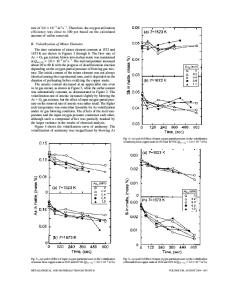Desulfurization kinetics of molten copper by gas bubbling
- PDF / 650,887 Bytes
- 7 Pages / 603.28 x 783.28 pts Page_size
- 66 Downloads / 365 Views
I.
INTRODUCTION
GAS bubbling or injection is one of the most important operations in metal refining processing. A number of papers have been published on the topics of mass transfer between molten metal and gas bubbles. The literature can be classified into two groups. The first concerns single gas bubbles, tl,21 in which the mass transfer rate in the liquid phase is analyzed using penetration theory; t31 the other concerns swarms of bubbles or jets. As it is almost impossible to evaluate the interfacial area of bubble swarms or jets, the rate of mass transfer is expressed in terms of a mass transfer parameter, which is defined to be the product of interracial area and the mass transfer coefficient. Themelis and Schmidt t41 measured the deoxidation rate of molten copper by blowing a CO gas jet through a submerged nozzle. They then correlated the observed mass transfer parameter with Reynolds number at the nozzle e~(it. Brimacombe e t al. tS] tried to explain the experimental results of the deoxidation at high temperature conducted by Themelis and Schmidt by using a mass transfer correlation which was obtained from the chemical absorption rate of SO2 gas into an aqueous H202 solution. This research has developed into the fields of mixing energy t61 and flow pattern dynamics, t71 The achievements in these fields are now widely utilized in steel-refining processes. As far as the mass transfer parameter is concerned, essentially no new developments have been reported since the early pioneering efforts. This is partly due to the extremely complicated hydrodynamical phenomena in multiphase flow. Another reason may also stem from our imperfect understanding of the gas-metal reaction. Since
Y. FUKUNAKA, Research Associate, K. NISHIKAWA, Undergraduate Student, H.S. SOHN, Graduate Student, and Z. ASAKI, Professor, are with the Department of Metallurgy, Kyoto University, Kyoto 606, Japan. Manuscript submitted November 10, 1989. METALLURGICAL TRANSACTIONS B
the desulfurization mechanism of molten copper is relatively simple and a considerable amount of thermodynamic data has been accumulated, this work deals with the analysis of mass transfer processes in the desulfurization of molten copper by gas bubbling. It is relatively easy to evaluate the interracial area in the bubbling mode, and the mass transfer coefficient can be estimated. Such work may provide fundamental knowledge for the elucidation of the mechanism of desulfurization in an anode furnace operated in the bubbling mode. [8,91
II.
EXPERIMENTAL
The Cu-S alloy was prepared by melting 12 kg of electrolytic copper in a graphite crucible at 1473 K, and 0.982 kg of Cu2S was added to adjust the sulfur content. After it was mixed, the melt was cast into an iron mold. The sulfur and oxygen contents of the cast copper were 0.74 and 0.01 wt pct, respectively. This copper was cut into many cubes whose volume was roughly 1 x 10 -6 ii13. Figure 1 shows the apparatus for the desulfurization experiment. An amount of 0.2 kg of copper, containing sulfur, was placed in an alum
Data Loading...











